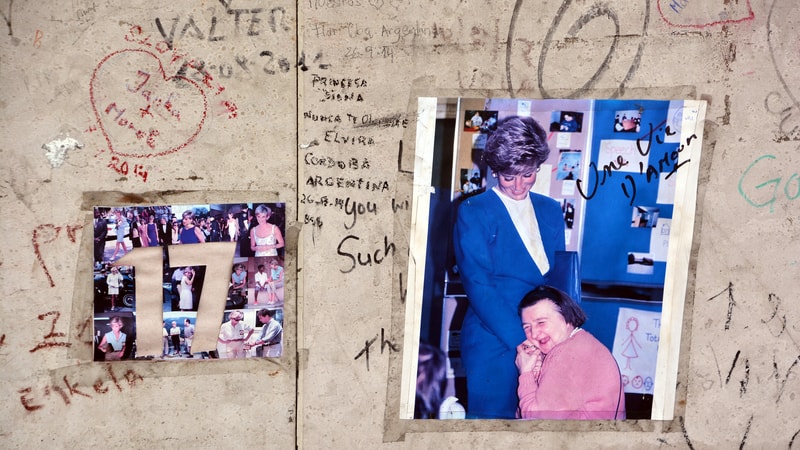Princess Diana: A Defiant Kindness
The play ‘Casey and Diana,’ along with her sons and contemporaneous events, demonstrate her heart

Her actions in life, the lessons her sons took from their time with her, and the play “Casey and Diana” demonstrate the compassion and the defiant kindness of Princess Diana.
A couple of months ago, I went to see a very moving play, “Casey and Diana.” It was performed, brilliantly, to a packed house at the Stratford Festival in Stratford Ontario.
Casey and Diana told the true story of Princess Diana’s courageous visit to Casey House in 1991. Toronto’s Casey House opened in 1988 and was among the first hospices in the world to provide palliative care and support for people living with HIV/AIDS. It was the brainchild of a courageous Toronto journalist, June Callwood.
The courage to care
Princess Diana’s visit to Casey house came about at a time of worldwide fear and homophobia surrounding HIV/AIDS. The play “Casey and Diana” highlighted not only her courage, but also the courage of nurses, volunteers, and caretakers who risked their lives caring for their dying patients. Diana’s visit set the stage for a still thriving hospice decades later.
Imagine the courage it took to follow her own path against the powers of the royal family. We are more aware of the royal family’s powers today, with the public airing of the problems encountered by Meghan Markle and Prince Harry.
Imagine the courage it took to risk her own life at a time when even medical professionals were terrified of this relatively unknown, contagious, and deadly illness.
The director for “Casey and Diana,” Andrew Kushnir, writes about what it was like in the early days of the AIDS pandemic that killed over 40 million people worldwide. He describes a young dying man’s food left cold, outside his room on the floor, because the hospital staff were afraid to bring it into him. There was signage recommending the donning of a hazmat suit and goggles for anyone entering patient’s room.
This did not deter Princess Diana from entering residents’ rooms, sitting on their beds, and engaging in close personal conversation.
A defiant kindness
Princess Diana was defiant in her determination to show compassion at a time when almost everyone else was too frightened to do so. And this defiance helped to change public attitudes around the world.
In a famous photograph, Princess Diana can be seen shaking hands with a Casey House resident, who was covered in Karposi sarcoma lesions related to the AIDS illness. Her simple act of compassion, where she visited and shook hands with the resident, appeared on the front page of newspapers everywhere. The photograph put a human face to the AIDS pandemic and helped counter the prevailing cultural anxiety and homophobia of the time.
With a simple, much-needed touch, Princess Diana showed us the way.
In the early years of the AIDS pandemic, people were often denied touch and human kindness. Andrew Kushnir cites Susan Sontag, who wrote that AIDS was a social death before it was a physical one. The play “Casey and Diana” highlights Diana’s touch and close contact with Casey House residents, as well as the courage of volunteers that provided much of the day-to-day care and support.
Princess Diana was able to build on this courage, showing fearlessness and compassion to those she described as being rejected by society. She became a patron of the Leprosy Mission in Great Britain. She was famously involved in landmine removal and was photographed walking through an Angolan minefield wearing protective gear.
Her values and kindness have been inherited by her children. Prince Harry has launched his own initiative to help fight homelessness. He was inspired by the “heart-breaking” trips he used to make with his mother. In a quote from the National Post Wire Service, Prince Harry says, “My first visit to a homelessness shelter was when I was 11, with my mother. The visits we made left a deep and lasting impression.”
The courage to be vulnerable

Kushnir wonders how Princess Diana’s visits with 13 men, on that historic day in 1991, changed her as well as the world. I think her acts of kindness strengthened her. In later years, she showed the courage to publicly acknowledge her own struggles. In a 1995 interview with BBC journalist Martin Bashir, Diana opened up about her own suffering related to bulimia and anxiety after her marriage to Prince Charles.
Princess Diana set the stage for allowing others, including her family, to be more transparent about their mental health. In recent interviews, Prince Harry broke with the royal family’s code of silence by explaining his almost complete breakdown after his mother’s death and his struggle 20 years later to still deal with this tragedy and loss. Prince William, Prince Harry, and Kate Middleton have spearheaded a charity, Heads Together, to help open up public conversation about mental health and to support children’s lives in school.
Roisin Kelly, in Parade (2017), offered a fitting quote from Princess Diana. “Two things stand like a stone. Kindness in another’s troubles and courage in your own.”
Kindness is serious business
It is fashionable in some circles to downplay the benefits of compassion and kindness. These actions and values have traditionally been seen as a form of weakness in a society that values a tough guy approach.
Phil Lewis, in Forbes, argued that this is a mistake and that training in kindness is a pillar of business and effective leadership. In fact, two of his main leadership pillars are compassion and courage. Essentially, this means being considerate and responsive to the needs of others. As Lewis argued, this “reflects the truth of kindness as a value that is hard-edged, practical and supportive. Kindness should never be mistaken for weakness.” Businesses, today, that don’t embrace this attitude through their actions risk alienation from their customers.
Princess Diana was serious about her work of kindness and compassion. She was willing to take on the royal family and risk her own safety, over and over again, in the face of a deadly disease. In fact, she was doing this at a time when even doctors and nurses were too afraid to care for patients with HIV/AIDS, without being fully gowned and gloved. Diana visited such patients with intimacy, kindness, and touch – and no protective gear.
A lot has been written about Princess Diana. We could all use a little more. The Trump era has set us back and championed a cowardly bullying approach to those in need of compassion and support. Many years later, Princess Diana still leads by example – the best kind of leadership.
Michael MacDonald is a semi-retired retired psychologist who has written a book about chronic pain, several ebooks and an ongoing website and blog called A Warm Heart. He is an avid hockey player and a big fan of RoomtoRead.org and similar charities which promote education and gender equality for girls in low-income countries.
FEATURE PHOTO CAPTION: Diana Princess of Wales visiting Interconnection Systems (Plessey) in South Shields 1992. South Shields/Visits/Princess diana Collection. Newcastle Libraries from Newcastle upon Tyne, England, PDM-owner, via Wikimedia Commons
More like the defiant kindness of Princess Diana:


